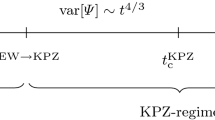Abstract
We present a simple argument to show that the β-function of the d-dimensional KPZ equation (d≥2) is to all orders in perturbation theory given by \(\beta (g_R ) = (d - 2)g_R - [2/(8\pi )^{d/2} ]{\text{ }}\Gamma (2 - d/2)g_R^2 \) Neither the dynamical exponent z nor the roughness exponent ζ have any correction in any order of perturbation theory. This shows that standard perturbation theory cannot attain the strong-coupling regime and in addition breaks down at d = 4. We also calculate a class of correlation functions exactly.
Similar content being viewed by others
REFERENCES
M. Kardar, G. Parisi, and Y.-C. Zhang, Dynamic scaling of growing interfaces, Phys. Rev. Lett. 56:889–892 (1986).
Timothy Halpin-Healy and Yi-Cheng Zhang, Kinetic roughening phenomena, stochastic growth, directed polymers and all that, Phys. Rep. 254:215–415 (1995).
J. Krug, Origins of seale invariance in growth processes, Advances in Physics 46:139–282 (1997).
E. Frey and U. C. Täuber, Two-loop renormalization group analysis of the Burgers-Kardar-Parisi-Zhang equation, Phys. Rev. E 50:1024–1045 (1994).
Kay Jörg Wiese, Critical discussion of the 2–loop calculations for the KPZ equation, Phys. Rev. E 56:5013–5017 (1997).
M. Lässig, On the renormalization of the Kardar-Parisi-Zhang equation, Nucl. Phys. B 448:559–574 (1995).
J. Zinn-Justin, Quantum Field Theory and Critical Phenomena (Oxford University Press, Oxford, 1989).
H. K. Janssen, private communication.
J. Z. Imbrie and T. Spencer, Diffusion of directed polymers in a random environment, J. Stat. Phys. 52:609 (1988).
J. Cook and B. Derrida, Polymers on disordered hierarchical lattices: A nonlinear combination of random variables, J. Stat. Phys. 57:89–139 (1989).
R. Bundschuh and M. Lässig, Directed polymers in high dimensions, Phys. Rev. E 54:304–320 (1996).
E. Medina, T. Hwa, M. Kardar, and Y. C. Zhang, Burgers equation with correlated noise: Renormalization group analysis and applications to directed polymers and interface growth, Phys. Rev. A 39:3053 (1989).
Author information
Authors and Affiliations
Rights and permissions
About this article
Cite this article
Wiese, K.J. On the Perturbation Expansion of the KPZ Equation. Journal of Statistical Physics 93, 143–154 (1998). https://doi.org/10.1023/B:JOSS.0000026730.76868.c4
Issue Date:
DOI: https://doi.org/10.1023/B:JOSS.0000026730.76868.c4




